While Batman was a huge hit in the summer of 1989—against some stiff competition, including Lethal Weapon 2, Indiana Jones and the Last Crusade, Star Trek V: The Final Frontier, Dead Poets Society, Back to the Future Part II, Ghostbusters II, and The Little Mermaid, among others—Batman Returns was considered a box office disappointment, grossing considerably less. Warner Bros. shook things up, asking Tim Burton to step aside (though he still produced the next film) and assigning Joel Schumacher to take over the directorial reins.
Where Burton was at least partly inspired by the darker Batman comics of the 1970s and 1980s, Schumacher went back to the 1950s comics and the 1960s TV show for inspiration, eschewing the dark knight and embracing the caped crusader.
With Burton’s departure, Michael Keaton stepped down, disliking the lighter tone, replaced by Val Kilmer, who took the role without reading the script. Despite the stated disappointment with Returns, which had two villains, they had two villains in this one, too, re-casting Harvey Dent with Tommy Lee Jones, replacing Billy Dee Williams—who’d been cast in the 1989 film for the express purpose of coming back later as Two-Face—and with Jim Carrey as the Riddler. Chris O’Donnell was brought in as Robin.
Batman Forever did well enough to green-light a fourth film almost immediately, but Kilmer and Schumacher apparently did not get along particularly well, plus the accelerated schedule meant a conflict with Kilmer, who had taken the title role in The Saint. Kilmer was replaced by George Clooney, who teamed up with O’Donnell and Alicia Silverstone as Batgirl to face three villains: Mr. Freeze (Arnold Schwarzeneggar), Poison Ivy (Uma Thurman), and Bane (Robert “Jeep” Swenson). This combo proved less than efficacious and this particular series—which were all part of the same continuity, but with only Michael Gough as Alfred and Pat Hingle as Gordon being in all four of them—ended with 1997’s Batman & Robin.
“Was that over the top? I can never tell…”
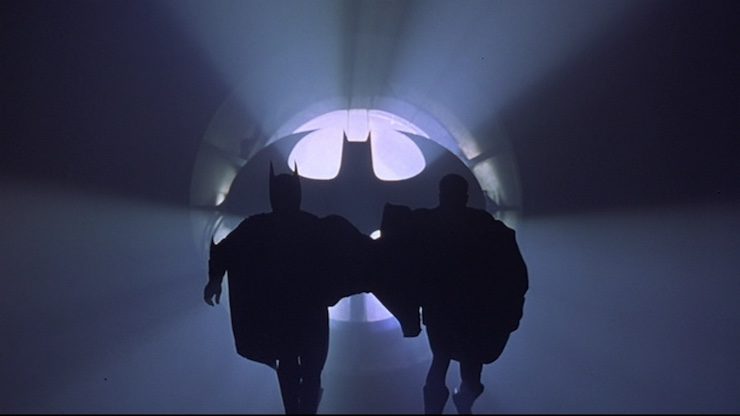
Batman Forever
Written by Lee Batchler & Janet Scott Batchler and Akiva Goldsman
Directed by Joel Schumacher
Produced by Tim Burton and Peter MacGregor-Scott
Original release date: June 16, 1995
The Bat-signal shines in the night sky, as Two-Face has hit the Second National Bank on the second anniversary of the first time Batman captured him. Gordon has brought in a shrink, Dr. Chase Meridian, and she flirts inappropriately with Batman in the middle of a crime. Two-Face locks a guard in a vault, and uses him as bait for Batman, who tries to rescue the guard. Two-Face then closes the vault door and pulls it out a hole in the wall, intending to carry it off with a helicopter while filling it with the same acid that scarred half of Harvey Dent’s face, turning him into Two-Face.
Using the guard’s hearing aid to help hear the tumblers, Batman opens the vault door. How he heard anything through his cowl is left as an exercise for the viewer. He is able to return the vault and the guard to the bank and then saves himself, though Two-Face escapes.
Later, Bruce Wayne tours one of his scientific facilities, where he meets Edward Nygma, who has developed something that can project images into people’s brainwaves. Nygma hero-worships Wayne, so he’s crestfallen when Wayne decides his research is too dangerous and refuses to continue to fund it. Nygma is devastated, and he not only continues his work, but when his supervisor discovers him continuing it, Nygma kills him—but not until after he absorbs his mental energy into himself, making him cleverer, supposedly.
Nygma alters the security footage and forges a suicide note so everyone thinks he killed himself. Nygma quits, feigning devastation at the loss of a colleague. He then goes on to form “NygmaTech,” using his brainwave doodads to create convincing holographs that are beamed directly into people’s brains. The Nygma Boxes are a huge hit, and Nygma is also using them to absorb brainwaves the way he did with his erstwhile boss, making himself allegedly smarter. Nygma also leaves riddles for Wayne.
Two-Face continues his reign of terror. At one point, the bat-signal goes off and then Two-Face chases the Batmobile. It’s unclear what happened to prompt the bat-signal in the first place, but Batman gets away from Two-Face easily. Meridian also uses the bat-signal to summon Batman so she can flirt with him some more. Wayne decides to consult Meridian about the riddles he’s received, and he also invites her to a charity circus.
At the circus, Two-Face attacks right after the Grayson family do their trapeze act. Two-Face wants Batman to show himself, and he’s put two hundred sticks of TNT in a wrecking ball. Wayne manages to take out some of the thugs in his civvies. Dick Grayson manages to toss the wrecking ball into the river, but his parents and brother are killed by Two-Face in the meantime.
Grayson is devastated. Wayne offers to take him in, and Grayson agrees long enough to satisfy Gordon, but then he plans to leave—right up until he sees Wayne’s car and motorcycle collection and Alfred’s cooking skills…
Nygma, having taken on the persona of “the Riddler,” discovers Two-Face’s lair and shows him the brain-sucking technology. Two-Face is (naturally) of two minds about whether or not he should kill Riddler, but as usual he lets his coin decide, and it comes up heads, so they team up. (For some reason, the coin is a regular coin with tails scratched up. This makes little sense, as the whole point is that Two-Face is two sides of the same coin, which is why he flips a two-headed coin, one of which is scarred. It symbolizes his duality. That the filmmakers don’t even get the basic symbolism of Two-Face is endemic of the issues these two movies have……)
Grayson wants revenge on Two-Face. Wayne refuses to help him. Grayson discovers the Batcave and takes the Batmobile out for a spin, trying and failing to be Batman before the real McCoy shows up. Grayson wants to be Batman’s partner, but Wayne refuses, going so far as to give up being Batman rather than let Grayson risk his life.
Riddler and Two-Face go on a robbery spree that Batman basically ignores. Nygma’s launch of NygmaTech also goes unchallenged, and it’s such a huge financial success that one wonders why he needs to also rob banks and jewelry stores and such.
Wayne talks to Meridian about some suppressed memories he has of his parents’ death, and also flirts with her, but she’s only interested in Batman. Later, when Batman comes to her apartment, she greets him dressed only in a bedsheet, kisses him, and then realizes that she actually is fond of Wayne. When Batman leaves and turns away, he smiles.
Nygma holds a party for the launch of NygmaTech, and he uses his tech to scan the brain patterns of the guests, including Wayne. They’re interrupted by Two-Face breaking in and robbing the guests. Afterward, Riddler reveals that Wayne’s brain is completely filled with images of bats.
Meridian and Wayne have dinner, and when they kiss, Meridian realizes that Wayne is Batman. This revelation is interrupted by Two-Face and Riddler attacking Wayne Manor, kidnapping Meridian, shooting Wayne (only a grazing shot to his scalp), and trashing the Batcave. Grayson and Alfred nurse him back to health, and Grayson puts on a costume based on his circus outfit, and calls himself “Robin” after a nickname he had in the circus. Batman and Alfred deduce that Riddler is Nygma, and Batman and Robin head to the island NygmaTech bought, in the Bat-plane and the Bat-boat (the only two vehicles left after Riddler trashed the place).
Robin is captured, but Batman manages to break Riddler’s machine, which overloads his brain, and rescue both Robin and Meridian. Two-Face is about to shoot them when Batman reminds him to flip the coin first. Two-Face thanks him for the reminder, but as he flips it, Batman throws several coins in the air, confusing Two-Face, and as he flails, he falls to his doom.
Batman and Robin continue to fight crime, while Meridian wonders if dating a superhero is such a hot idea.
“This is why Superman works alone…”

Batman & Robin
Written by Akiva Goldsman
Directed by Joel Schumacher
Produced by Peter MacGregor-Scott
Original release date: June 20, 1997
Batman and Robin suit up, with the camera taking in loving closeups of the rubber nipples on both men’s suits, as well as their crotches and asses. They’ve been summoned because there’s a new super-villain in Gotham: Mr. Freeze, who is stealing a very large diamond. Batman and Robin try to stop him, but they keep being sidetracked by Freeze’s thugs, who are numerous and all apparently trained in martial arts. Freeze gets away when he freezes Robin and Batman is forced to stay behind and save his partner rather than chase Freeze.
Some research reveals that Mr. Freeze is, in fact, Dr. Victor Fries, whose wife came down with a rare disease. He froze her cryogenically while he searched for a cure, but he fell into a vat of cryonic fluid which means he only can survive in sub-zero temperatures. It also made him binky bonkers crazy. However, he’s still searching for a cure for his wife, and he spends his spare time watching old movies of their wedding and such.
In South America, Dr. Pamela Isley and Dr. Jason Woodrue are doing experiments for Wayne Enterprises. Isley is trying to make plants robust enough to survive on their own without human help, while Woodrue has been stealing Isley’s work in order to create “venom,” which he uses to create Bane, a not-too-bright superman. Woodrue has also been keeping the fact that Wayne shut down the project from Isley. When Bane goes nuts and trashes the place, Isley threatens to expose Woodrue, so Woodrue kills her—or so he thinks. Instead, the toxins and venoms she’s been working with mix with the soil and the plants and turn her into Poison Ivy. She has pheromones that can ensorcel any man to her will and her lips are coated in poison so a kiss kills. She kills Woodrue, gets Bane to do her bidding, er, somehow, and they fly to Gotham City.
During the opening of a new Gotham Observatory—which will use a large telescope and a network of satellites to not only look into space, but also at places all over the globe—Isley confronts Wayne, who rebuffs her. When she points out that Mother Nature will always prevail and nobody will protect them, the crowd laughs at her and says Batman and Robin will protect Gotham always, prompting Isley to want to take them down.
Alfred’s niece Barbara is visiting from Oxbridge, though it is soon revealed that she got kicked out of the university. Her parents were killed in a car crash, and her way of acting out was to go on underground motorcycle races. Grayson follows her to one of those races and joins it, saving her life when one contestant cheats.
Barbara also knows something Grayson doesn’t, though Wayne has figured it out: Alfred is dying. What’s worse, Fries found a cure for what ails Alfred, but he never published his findings before he went nuts.
In order to lure Freeze into the open, Wayne Enterprises hosts an event that has the Wayne diamond collection as its centerpiece, with Batman and Robin as special guests. But Ivy shows up first, and uses her pheromones to seduce both Batman and Robin, which leads to them fighting over her.
However, the love triangle is interrupted by Freeze, who steals the diamond from Ivy. (Freeze is immune to her pheromones.) Batman and Robin give chase, though Batman stops Robin from doing something particularly dangerous. Batman captures Freeze, who is sent to Arkham Asylum. Ivy and Bane break him out, killing several guards. She retrieves his equipment and unplugs Freeze’s wife’s cryochamber, not interested in the competition, though she later tells Freeze that Batman did it.
Robin is still obsessed with Ivy, convinced that Batman is jealous because she loves Robin and not Batman. Meanwhile, Alfred’s condition is deteriorating. He gives Barbara a CD with instructions for his brother Wilfred, but Barbara goes ahead and reads the CD herself, discovering that Wayne and Grayson are really Batman and Robin. Alfred anticipated her doing so, and created a bat-suit for her. She puts it on, and we get loving views of her boobs, crotch, and ass as she does so.
Wayne convinces Grayson to trust him that Ivy is dangerous and only wants to kiss him to kill him. So he goes to her when she summons him, but wears rubber lips to protect himself. Sure enough, she announces that the kiss she just gave him will result in death, making Robin realize that their love is a sham. He and Batman attack Ivy, but her plants imprison both of them. However, Barbara—in costume and calling herself Batgirl—attacks Ivy and takes care of her. Ivy revealed to Robin that Freeze plans to put the entirety of Gotham on ice from the observatory. Batman isn’t thrilled that Barbara has forced herself onto the team, but he gives in, and the three of them change into polar uniforms and try to stop Freeze—while the villain succeeds in freezing all of Gotham, our heroes are able to reverse the process by using the telescope and the satellites to, basically, beam sunlight from the other side of the world onto Gotham.
Robin and Batgirl are able to stop Bane by knocking his hoses out. Batman is able to save the two scientists working the telescope, whom Freeze froze, and then convinces Freeze that Ivy was the one who pulled the plug on his wife—but also that she’s still alive, as they were able to restore her cryochamber. Batman promises to let him work on his wife’s condition in Arkham Asylum in exchange for the cure to Alfred’s disease. Freeze agrees. As an added bonus, Ivy is his cell mate, and he intends to torment the hell out of her for trying to kill his wife.
Alfred is cured. Wayne reluctantly lets Batgirl join the team. Alfred opines that they’re going to need a bigger cave.
“If I must suffer, humanity will suffer with me!”
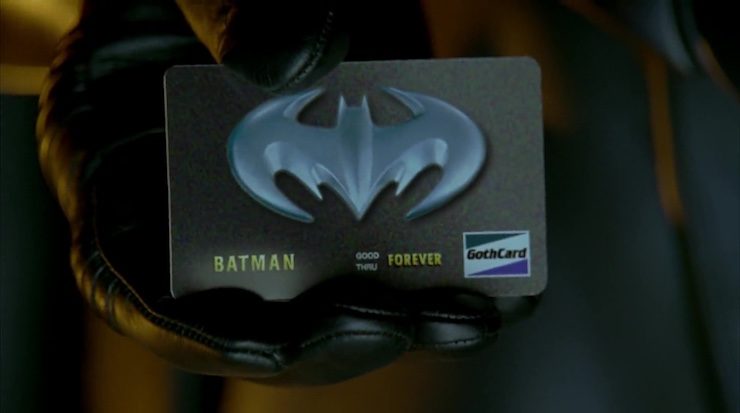
I was on WBAI-FM’s Hour of the Wolf radio show recently, and a bunch of us were discussing Star Trek Discovery. Akiva Goldsman is one of the executive producers of the show, and he cowrote the first episode and directed the third. One of the other panelists, movie critic Dan Persons (who had only seen “The Vulcan Hello,” and was not impressed), opined that Goldsman might well kill Star Trek the way he killed Batman.
While I disagree with the larger point, Goldsman did the dark knight no favors. These two movies didn’t actually kill Batman. For starters, the character has continued unabated in his original form of comic books. Batman has appeared in at least one, and often two or three, comics per month consistently since 1939. And while Goldsman’s awful scripts for these two movies helped kill this particular series of movies (a planned fifth film, Batman Unchained, was scrapped due to the overwhelmingly negative response to Batman & Robin), the next Bat-film would come along eight years later and be one of the most popular and impressive screen adaptations of the character ever done.
So no, Goldsman didn’t kill Batman.
But man, did he and Joel Schumacher do some serious damage.
My impression upon rewatching these two movies is the same one I had in the mid-1990s when I saw them the first time: these two movies have absolutely no relationship to the human condition. There are no people in this movie, only cackling caricatures. Goldsman’s dialogue is uniformly awful, the plots are overstuffed, overcrowded, and incoherent, the lines meant to be funny are groan-inducing, and the attempts at in-depth characterization are half-hearted and lame. In Tim Burton’s movies, Batman was a mysterious vigilante who was needed to keep a corrupt town in order. In Schumacher’s, he’s the celebrity hero that we saw Adam West play—he’s even got an American Express card! (Quite possibly the stupidest moment in any superhero film is when Batman declares that he never leaves the cave without it.)
With every single villain—Two-Face, Riddler, Mr. Freeze, Poison Ivy, Bane—they took a complex character from the comics (or from the animated series in Freeze’s case, as they used the Victor Fries backstory Paul Dini & Bruce Timm came up with for the “Heart of Ice” episode) and made him or her significantly less interesting.
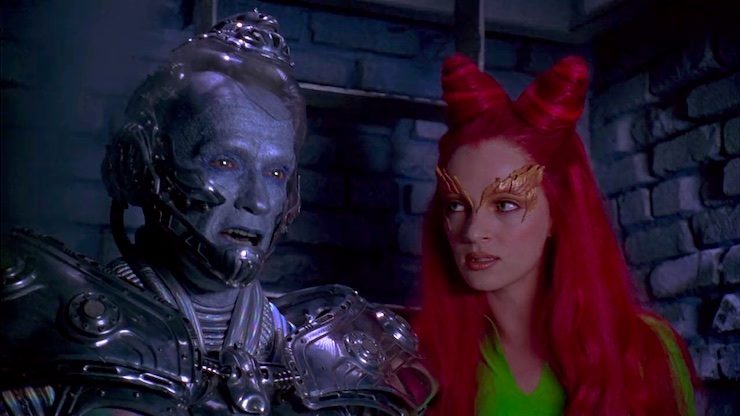
Bane was an intelligent, clever adversary who actually defeated Batman so thoroughly that someone else had to take his place. (Tom Hardy’s version in The Dark Knight Rises was much closer to the source material, albeit with whitewashed casting.) Goldsman & Schumacher turned him into Universal’s Frankenstein monster, a barely sentient thug.
Poison Ivy was a plant-lover who took that love to its criminal extreme, but who actually had some depth to her passions. In the hands of Uma Thurman—who can act, though you’d never know it from this film—she’s turned into a broad cartoon, a low-rent version of Michelle Pfeiffer’s Catwoman only without the gravitas or the depth.
Riddler is utterly unrecognizable here, as there’s no interest in doing the character from the comics, instead doing Ace Riddlura, Bat Detective—the character was suborned to Jim Carrey doing his OTT goofball act.
Mr. Freeze winds up being this weird combination of the wisecracking loons we saw in the 1966 series (particularly Otto Preminger’s interpretation) and Michael Ansara’s version in the animated series. But Freeze’s awful cold puns (and they’re simply endless) and the absurdity of his entire setup (how does he pay for this? why is he smoking a cigar in sub-zero temperatures? an ascot? seriously?) ruin the pathos of his love for his dying wife.
But the worst, the absolute worst, sin committed by any Bat-film in history is the travesty done to Two-Face.
First of all, what a friggin waste of Tommy Lee Jones! Here we have an actor who truly could successfully portray the duality of Two-Face, the constant war between his good and bad halves. But instead, he’s doing Joker lite, pure goofball mugging for the camera, and while it’s more effective than Nicholson’s turn in the 1989 film, Jones just can’t keep up with Carrey’s rubber-faced antics.
And we know Jones could pull off a more complex portrayal of Harvey Dent because he does it for about half a second at the very end of the film. The bit at the end when Batman reminds him to flip the coin and Harvey thanks him for being a good friend—that’s the only time in the entire damn movie that we see Harvey Dent as opposed to Two-Face (inexplicably referred to as “Harvey Two-Face” throughout), and we have to sit through an entire movie of Carrey and Jones cackling at each other endlessly before we get the character we were promised.
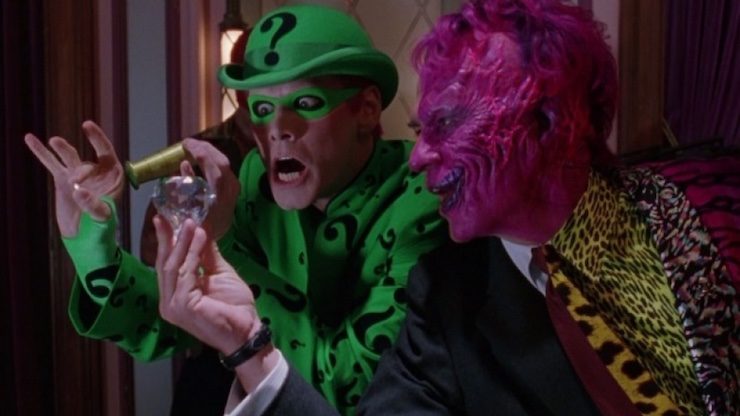
Our two new leading men are perfectly fine. Neither of them does enough to differentiate Batman from Bruce Wayne. Val Kilmer is completely adequate, but his calm hero persona is a letdown after the more nuanced performance Michael Keaton attempted.
As for George Clooney, he has very generously taken all the blame for Batman & Robin‘s failure, and he has taken a lot of heat for his work here, but honestly? Aside from Michael Gough, who is his usual superb self, he’s the only person actually acting in this movie. Everyone else is posturing or posing or overacting or just being very bad at their jobs. Clooney at least creates a convincing persona, particularly when he’s Wayne. Back in 1995, during promotional interviews for Batman Forever, Schumacher said that with actors this good, he didn’t have to direct anyone. Well, Joel, we can tell, as you’ve presented us with some of the worst performances of the careers of Jones, Thurman, John Glover (dementedly awful as Woodrue), Alicia Silverstone (completely pointless as Batgirl), Drew Barrymore, and Debi Mazar (the latter as Two-Face’s light and dark molls, both dreadful).
I didn’t include Chris O’Donnell in that list, because I’m still waiting for a good performance from O’Donnell. (He’s the main reason why I find NCIS: Los Angeles to be unwatchable.) His Robin is abominable. Worse, the character serves absolutely no function. If you remove Robin from either film, not a single significant thing changes. He’s utterly superfluous.
Back in 1995, I wondered why the movie was called Batman Forever, and upon watching it, I discovered the reason: that’s how long it takes. Both these movies are horrendously paced, seemingly taking ages and ages so that you’re squirming in your seat wondering when the nightmare will finally end.
Burton’s movies were flawed, but they were Citizen Kane compared to these two misbegotten disasters.
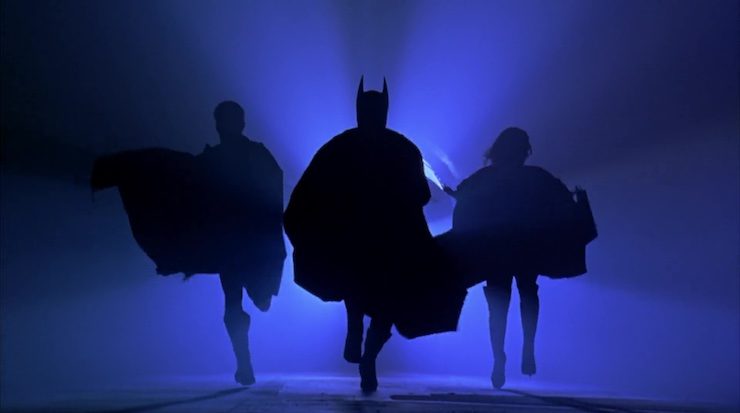
Next week, we’ll go back to the 1970s and the two TV-movies that kicked off Marvel’s biggest 20th-century success in the world of adaptation: The Incredible Hulk.
Keith R.A. DeCandido is working on a project that involves Poison Ivy. But it’s the comics version, thank goodness…











I liked Batman Forever, and although I saw many of the power nerds cringing at the comicky campy look I loved it. I love camp and I’m not ashamed to say I love it. I don’t know why so many of the powernerds are.
Batman and Robin, I didn’t like so much. It wasn’t the campiness of it that put me off, it was that it was just a bit dull. I can’t put my finger on it, but it just seemed a bit boring. Maybe if it had been more campy.
I quite liked Batman Forever, too, when I first watched it. I was 14 back then, which probably explains it. It couldn’t beat Tim Burton’s Batman films, but I enjoyed the campiness.
Batman & Robin is cringeworthy, but good for drinking games.
When I first saw Batman Forever, I thought it was a distinct improvement on the Burton films. It was sillier, sure, but it actually portrayed Batman as a character I recognized as Batman. The moment in the opening fight where Batman caught a henchman teetering on the edge of an elevator shaft and saved his life made me cheer. Keaton’s “Batman” would’ve pushed the guy off and thrown a stick of dynamite after him.
But in subsequent viewings, with that initial sense of relief worn off, I was able to see how deeply flawed it is. Tommy Lee Jones, as you say, is totally wasted as Two-Face, and Two-Face as a character is totally wasted by the script. Jim Carrey is all wrong for the Riddler, because the Riddler is not just the Joker lite. Jokes are about laughing; riddles are about thinking and solving problems. The Riddler should be an intellectual, calculating foe, a chess player to rival Batman’s intellect. The movie makes an effort at that — they actually got New York Times crossword editor and NPR “Puzzle Master” Will Shortz to create Nygma’s riddles — but it doesn’t really work because it’s subsumed beneath all the wacky mugging and lunacy.
Also, Chris O’Donnell was too old to be Robin. I get why having a preteen boy wonder or even a teenager wouldn’t seem appropriate in this day and age, but O’Donnell just didn’t work in the role. And why do people today have to concoct convoluted bird-based excuses for the name “Robin?” The comics told us in the very first panel where The Sensational Character Find of 1940 appeared that he was “a laughing, fighting young daredevil who scoffs at danger like the legendary Robin Hood whose name and spirit he has adopted.”
As for Batman and Robin (which is ironically titled, since “Robin” is basically wearing a Nightwing costume throughout), it’s certainly dumb and goofy, but there are things I like about it, mainly the cast. George Clooney is immensely more convincing as Bruce and Batman than either Keaton or Kilmer — or even Bale, come to that. With a better script, he would’ve been superb in the role. (Full disclosure: My father was friends with his father Nick Clooney, who was also my favorite TV news anchor when I was young.) And Uma Thurman’s Mae West-ish Ivy is enormously fun and sexy. But its attempt to meld the tragic Mr. Freeze story with ’66-style goofery is bizarre, and its reinvention of Batgirl is terrible.
By the way, the Batgirl costume that Dina Meyer would wear in the Birds of Prey TV series a few years later was a repaint of the Batgirl costume from Batman and Robin. So it did eventually get worn by Barbara Gordon instead of Barbara Wilson or whatever.
“…this particular series—which were all part of the same continuity, but with only Michael Gough as Alfred and Pat Hingle as Gordon being in all four of them…”
Are the Schumacher movies really in the same continuity as the Burton movies, though? Sure, they reuse Gough and Hingle, but the rebooted James Bond movies kept Judi Dench as M, and most of the Highlander movies star Christopher Lambert even though no two of the sequels are in continuity with each other. So common casting doesn’t necessarily prove a common universe. Is there anything else besides casting that overtly links the Schumacher films to the Burton ones? Are the events of the Burton movies ever directly referenced in the Schumacher ones? I’ve never been quite clear on that.
@3 It’s ambiguous whether or not the Burton and Schumacher films are in the same continuity. The part that connects the two directors’ work the most is a reference to Catwoman’s clothing and whip by Chase Meridian in Batman Forever.
As Brandon says, Meridian makes a direct reference to Michelle Pfeiffer’s Catwoman in Batman Forever.
—Keith R.A. DeCandido
One good thing came out of Batman Forever: Hold Me Thrill Me Kiss Me Kill Me – one of the better U2 songs from the mid-90s. The film that I cobbled together in my head from the clips in the HMTMKMKM music video is vastly superior to the real thing, probably because the music video doesn’t use any of the dialogue!
From the same source, I also got the impression that Jim Carrey wasn’t so much doing Ace Riddler as attempting a Frank Gorshin impersonation. Clearly, he didn’t pull that off – but without the dialogue, it didn’t look so bad.
(FTR I have actually seen the whole film but it left virtually no impression on me – unlike the music video. And if that isn’t a damning indictment, I’m not sure what is!)
It was a lot more Ace Ventura (and the Mask) than it was Frank Gorshin, IMO…………..
—Keith R.A. DeCandido
@6/Athersgeo: I don’t remember that song, but I always kinda liked “Kiss from a Rose.”
And the best impression of Frank Gorshin’s Riddler is Mark Hamill’s Joker.
Unpopular opinion: I’d still rather watch these two than any of the Christopher Nolan films ever again. That said, this franchise definitely needed time off after these. I keep hoping we’ll get a Batman film that does justice to the character the way The Animated Series did, though it is entirely unlikely at this point, I think.
Also, I remember a rumor during the casting for Forever that Robin Williams was being considered for The Riddler. If the film would have done the character any justice, I think that would’ve been a great choice.